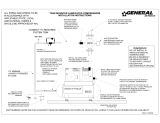
4 22607402 Rev.D
GENERAL SAFETY RULES
INHALATION HAZARD. Will cause serious injury or death.
Can contain carbon monoxide or other contaminants.
Ingersoll Rand air compressors are not designed, intended,
or approved for breathing air applications. Ingersoll Rand
does not approve specialized equipment for breathing air
application and assumes no responsibility or liability for
compressors used for breathing air services.
Do not directly inhale compressed air.
Follow precautions on container labels before spraying
materials such as paint, insecticide and weed killer.
Wear a respirator when spraying.
FLAMMABLE VAPORS. Can cause a re or explosion and result in
serious injury or death.
Do not operate electric motor driven compressors where
ammable or explosive liquids or vapors such as gasoline,
natural gas and solvents are present.
Do not operate gasoline engine driven compressors near an
open ame.
HAZARDOUS VOLTAGE. Can cause serious injury or death.
Disconnect power and relieve pressure from tank before
servicing.
Compressor must be connected to properly grounded circuit
by a qualied electrician following applicable electrical
codes. Refer to the ELECTRICAL CONNECTIONS section of this
manual.
Do not operate compressor in wet conditions. Store indoors.
MOVING PARTS. Can cause serious injury.
Do not operate with guards or shields removed, damaged or
broken.
Machine may start automatically. Disconnect power before
servicing.
HOT SURFACES. Can cause serious injury. Burns may occur.
Do not touch the compressor pump, motor or discharge
tubing during or shortly after operation. These parts become
hot. Allow to cool before touching.
HIGH PRESSURE AIR. Can cause serious injury.
Do not remove, adjust, bypass, change, modify or make
substitutions for safety/relief valves or other pressure control
related devices.
Rusted tanks can cause explosion and severe injury or death.
Drain tank daily or after each use. Drain valve located at
bottom of tank.
Do not over-pressurize the receiver tank or similar vessels
beyond design limits. Refer to compressor nameplate for this
information.
Do not use a receiver tank or similar vessels that fail to meet
the design requirements of the compressor. Contact your
distributor for assistance.
Do not drill into, weld or otherwise alter the receiver tank or
similar vessels.
Do not use air tools or attachments without rst determining
the maximum pressure recommended for that equipment.
•
•
•
•
•
•
•
•
•
•
•
•
•
•
•
•
•
•
•
•
Do not point air nozzles or sprayers toward anyone.
RISK OF BURSTING. Can cause serious injury.
Use only suitable air handling parts acceptable for pressure
of not less than the maximum allowable working pressure
of the machine. Refer to compressor nameplate for this
information.
FLYING DEBRIS. Can cause serious injury to eyes.
Wear eye protection at all times.
NOISE HAZARD. Can cause serious injury to ears.
Wear ear protection at all times.
Do not remove, paint over or deface decals. Replace any missing
decals.
SELECTING A LOCATION
ELECTRIC MOTOR COMPRESSORS
For most electric motor compressors, select a relatively clean and dry
well lighted indoor area with plenty of space for proper ventilation,
cooling air ow and accessibility. Provide 1,000 cubic feet of fresh air
per minute per 5 horsepower. Ventilation by gravity or mechanical
means is approved. Locate the compressor at least 12 inches (30 cm)
from walls, and make sure the main power supply is clearly identied
and accessible.
Unless the electrical components of the compressor are specially
protected for outdoor use, do not install an electric motor compressor
outdoors or in an area that will expose the electrical components to
rain, snow or sources of appreciable moisture.
FOR COMPRESSORS EQUIPPED WITH ELECTRIC DRAIN VALVES
The electric drain valve incorporates arcing or sparking parts,
such as snap switches, receptacles and the like that tend to
produce arcs or sparks and, therefore, when located in a garage,
the compressor should be in a room or enclosure provided for
the purpose, or the electric drain valve should be 18 inches (45
cm) or more above the oor. To relocate the valve, contact your
local Ingersoll Rand dealer to obtain an electric drain valve
relocation kit.
GASOLINE ENGINE COMPRESSORS
For gasoline engine compressors, keep the engine at least 3 feet (1 m)
away from building walls and other equipment. Install the compressor
in a location with plenty of space for proper ventilation, cooling air
ow and accessibility. Do not install or operate a gasoline engine
compressor in a conned area.
AMBIENT TEMPERATURE CONSIDERATIONS
Ideal operating temperatures are between 32°F and 100°F (0°C and
37.8°C). If temperatures consistently drop below 32°F (0°C), install the
compressor in a heated area. If this is not possible, you must protect
safety/relief valves and drain valves from freezing. If temperatures
are consistently below 40°F (4.4°C), consider installing an external
crankcase heater kit, especially if the compressor has diculty starting.
Never operate the compressor in temperatures below -15°F
(-26.1°C) or above 125°F (51.0°C).
•
•
•
•





















